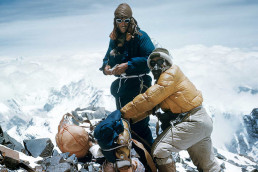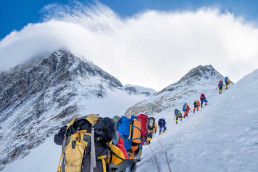Mount Everest, the world’s highest peak, rises 8,848 metre above the ground. Its snowy slopes tell stories of daring expeditions, stoic traditions, and the steadfast spirit of the Sherpas. For millennia, the Sherpas, an ethnic minority from the Khumbu region, have considered Everest massive home. Their lives are inextricably linked with the mountain, which they venerate as Chomolungma, “Goddess Mother of the World.”
The first reported European attempt on Everest was in 1921. These early trips were primarily reconnaissance efforts, testing the mountain’s defences and scouting possible paths. Success depended on the Sherpas’ knowledge and fortitude. Their extensive knowledge of the perilous Khumbu Icefall, a vast area of crevasses and glacier debris guarding Everest’s foot, proved vital. They transported supplies, set up camps, and marked pathways through the treacherous terrain, all while braving the harsh weather at high altitude. Tenzing Norgay, the great Sherpa mountaineer, exemplified Sherpa resilience. He took part in multiple excursions during the 1930s and 1950s, honing his skills and understanding of Everest. In 1953, he and Edmund Hillary, a New Zealand climber, became the first humans to reach the peak. This epic ascent not only marked a watershed moment in mountaineering, but it also propelled the Sherpas into the international spotlight, forever altering their status on Everest.
Today, Everest draws a new type of adventurer. Commercial expeditions have made the summit accessible to a broader variety of climbers, from experienced mountaineers to individuals seeking a once-in-a-lifetime challenge. Nonetheless, the trek remains perilous. The harsh “death zone” at 8,000 metre, with its freezing temperatures and oxygen-depleted environment, continues to claim lives. It is here that the Sherpas’ abilities are most important. They repair ropes, the lifelines that let climbers to safely ascend and descend, set up camps that give critical shelter at high elevations, and lead climbers through dangerous areas like as the Hillary Step, a near-vertical rock wall. They bear enormous responsibility for the expedition’s success – and, in many cases, its survival.
Everest, however, is not impervious to change. Climate change is dramatically changing the mountain scenery. Rising temperatures have accelerated glacier melt, resulting in hazardous icefalls and unpredictable weather patterns. The once-predictable climbing season is becoming more irregular, with shorter periods of clear weather and more powerful storms. The Khumbu Icefall, formerly a severe but manageable challenge, has become a dynamic maze of crevasses and sliding ice seracs, posing a considerable threat to climbers. Melting permafrost reveals previously buried dead, creating ethical concerns about how to manage the mountain’s dark history. Sherpas’ ropes can freeze in place, becoming lethal snares for climbers.
The future of Everest is unknown. However, one thing is certain: Sherpas will continue to play an important role. Their strong ties to the mountain, passed down through generations, and steadfast spirit are as important to Everest’s tale as the majestic peaks itself. They are the mountain’s gatekeepers, and they know its moods and secrets. As Everest faces the challenges of a changing climate, the Sherpas’ knowledge and adaptability will be more valuable than ever.





